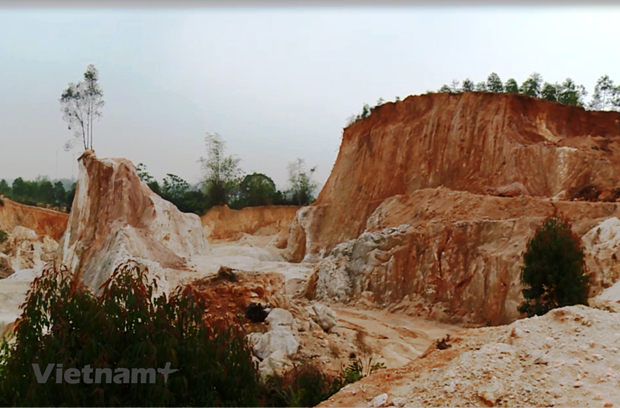Management of mineral resources requires more efforts
Mineral resources are vital to the nation as they not only serve economic development purposes, but also hold the potential for reinvestment in and sustainable development of tourism, such as Dong Van Karst Plateau Geopark and Non Nuoc Cao Bang Global Geopark.
 A hill devastated by mining activities in Tan Phuong commune, Thanh Thuy district, in 2018 (Photo: VietnamPlus)
A hill devastated by mining activities in Tan Phuong commune, Thanh Thuy district, in 2018 (Photo: VietnamPlus)Hanoi (VNA) – Mineral resources are vital to the nation as they not only serve economic development purposes, but also hold the potential for reinvestment in and sustainable development of tourism, such as Dong Van Karst Plateau Geopark and Non Nuoc Cao Bang Global Geopark.
Discussing at a talk on managing and using mineral resources properly on February 25, experts recommended that revenues from minerals should be used to re-invest in sustainable development, thus turning potential into a driving force.
Lai Hong Thanh, deputy head of the General Department of Geology and Minerals, said that after revisions were made to the 1989 Ordinance on Mineral Resources, the 1996 Mineral Law, the 2010 Mineral Law, and nearly 50 circulars, the system of policies and legal documents on minerals has been basically completed.
“This has created an important legal corridor and the foundation for the preservation of mineral resources and the sustainable development of our country's mining industry,” he said.
The mining sector provides materials for other economic sectors, with tens of million tonnes of coal and hundreds of million cubic metres of limestone to make cement each year, not to mention oil and gas and other minerals, Thanh stated.
However, he pointed to existing shortcomings in the management and exploitation of mineral resources, particularly river-bed sand, coal and limestone in many places.
Therefore, in the coming time, it is necessary to evaluate the potential of mineral resources through investigations and statistics so as to make detail strategies and plans.
Regarding the illegal exploitation and export of minerals, Thanh acknowledged that the punishments were not strict enough.
Therefore, he said, the Government issued Decree No.142 which was then replaced by Decree No.33 on punishments of administrative violations related to mineral exploitation.
Since the penalties were issued, the management has shown many changes for the better, reflected through decreases in illegal mineral exploitation cases every year.
“However, in fact, it has yet to meet requirements. Thus, the Ministry of Natural Resources and Environment is building a new decree on natural resources and mineral management to replace Decree No.33 and submit it to the Prime Minister,” Thanh stated.
In terms of policy research, Nguyen The Chinh, head of the Institute of Strategy and Policy on Natural Resources and Environment, said that in the context of the country shifting from centralised planning (which means all management belongs to the State) to a market economy, the country cannot avoid shortcomings and needs to handle them step by step.
According to Chinh, minerals are important to economic sectors, and are considered as the people’s assets.
“We need consider which minerals are of strategic importance that need to be exploited and used. We can buy cheap minerals, but we should not sell important minerals despite their high prices,” Chinh stressed.
Defining resources to exploit properly
Thanh stressed that minerals are a non-renewable resource that needs sustainable exploitation. That is also the reason why it is necessary to identify specific potential and resources so as to have a reasonable exploitation method.
Organisations and individuals that exploit minerals should be responsible for thoroughly exploiting minerals underground, including poor minerals.
“This requires us to further improve the legal system on minerals,” said Thanh.
 Talk on managing and using mineral resources properly (Photo: VietnamPlus)
Talk on managing and using mineral resources properly (Photo: VietnamPlus)Meanwhile, Chinh emphasised the need to get accurate and specific statistics about the country’s mineral potential and reserves, and long-term market forecasts.
Turn potential into driving force
In addition to assess resources, managing and developing minerals towards turning them from potential to driving force is essential, Chinh said.
He proposed Vietnam learn from international experience to keep essential mineral resources for the future.
Sharing the same view, Thanh said that mining enterprises now have paid more attention to environmental protection.
However, Thanh also noted that after the mines are exhausted, they will be closed.
He suggested developing tourism after mine closure, citing the example of the Buu Long tourist site in Dong Nai province.
Thanh stressed the need to have long-term assessments of mineral resources in the direction of storing resources for long-term, towards the goal of exploiting and using natural resources properly, effectively and sustainably by 2050./.
| The General Department of Geology and Minerals of Vietnam has announced a "blacklist" of mining enterprises which have committed many violations in exploiting limestone to produce cement such as Song Lam Cement Joint Stock Company and Song Lam 2 JSC (both belong to The Vissai Group), Fico Tay Ninh Cement JSC, Ha Tien Cement JSC and Ha Tien 1 Cement JSC. |













